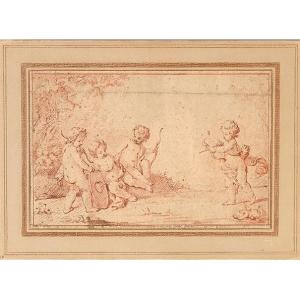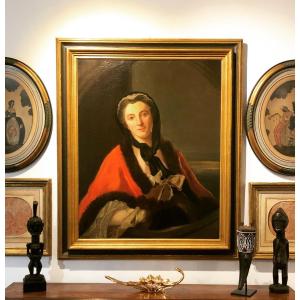H. 46 ; W. 38.5 cm
Carved and gilded wooden frame in the Louis XIV style
Handwritten inscriptions on the back of the frame: “Madame la Marquise de Feuquières by P. Mignard in 1655”
Re-lined and restorations, probably 19th century
This charming bust portrait after Pierre Mignard depicts an elegant 17th century lady. The model is posed in a three-quarter view, her head slightly turned towards the viewer. Her amused expression is enhanced by her enigmatic smile. She is wearing a brocade dress decorated with lace. Her neck and hair are decorated with rows of pearls. According to an old handwritten inscription on the frame of the work, this portrait was supposed to represent the Marquise de Feuquières in 1655, namely Anne-Louise de Gramont (1627-1666), who held the title at the time. Anne-Louise came from a prominent French noble family, deeply involved in the military and political affairs of the country. Its members, assiduous courtiers of the royal family, held a prominent place at court. She was also the granddaughter of Diane D'Andoins, known as 'the beautiful Corisandre', a great favourite of Henry IV when he was King of Navarre. In 1647, she married Issac de Pas de Feuquières (1618-1688), lieutenant-general of the king's armies, governor of Verdun, viceroy of the Americas and ambassador extraordinary to Sweden and Spain.The couple had nine children before the Marquise's untimely death in 1666.
Anne-Louise de Gramont, like many of her close contemporaries, including the famous Madame de Sévigné, commissioned Pierre Mignard to paint her portrait (the original seems to have been lost). From the second half of the 17th century, the painter enjoyed phenomenal success in France. He was particularly appreciated by the ladies, of whom he painted flattering effigies.
According to contemporary writings and archives, Mignard also painted the portraits of Antoine III, Marshal of Gramont, and Philibert, Count of Gramont, Anne-Louise's brothers; that of the Marquis of Feuquières, her husband, and that of her sister, Charlotte-Catherine de Gramont.
However, the date of 1655 on the back of the painting does not seem plausible. Pierre Mignard was still in Italy at the time and did not return until 1657. This could be an error on the part of the author of the inscription, but it is also possible that the Marquise met the artist during a trip to Italy?
Pierre Mignard seems to have been particularly close to the Gramonts and the Feuquières. Anne-Louise's son, Jules de Pas, married the artist's daughter, Catherine Mignard, in 1696.
The work was re-lined, probably in the 19th century. The method used slightly flattened the pictorial layer, which lost its relief. Skilful restoration must have been carried out at the same time. Very good overall condition. Sold in its Louis XIV style carved and gilded wooden frame.



























 Le Magazine de PROANTIC
Le Magazine de PROANTIC TRÉSORS Magazine
TRÉSORS Magazine Rivista Artiquariato
Rivista Artiquariato